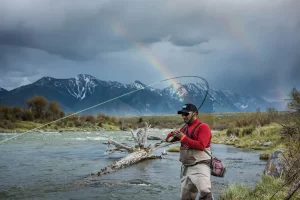Fly fishing, with its graceful casting and strategic approach, offers a rewarding way to connect with nature and catch fish. However, it differs significantly from traditional spin or bait fishing. For those wondering whether they’re ready to take on fly fishing, there are a few key factors to consider before diving into this specialized angling method.
Understanding the Difference
Fly fishing involves casting a lightweight, artificial fly using a special rod and line. Unlike traditional spin fishing, where the weight of the lure helps propel the cast, in fly fishing, the line itself provides the weight to carry the fly. The presentation is delicate, often targeting fish in clear water where they can see the fly before striking.
Before switching to fly fishing, it’s important to understand this difference in technique. Fly casting requires practice, as the movement is much more fluid and involves a precise rhythm compared to the direct casting in spin fishing.
Appreciating the Challenge
Fly fishing is often seen as a more challenging method of fishing. It requires patience, finesse, and knowledge of entomology (the study of insects). Flies are designed to mimic the insects that fish feed on, so understanding which flies to use, and when, is crucial to success.
Anglers who enjoy problem-solving, learning, and refining techniques will likely thrive in fly fishing. It requires an openness to learning new methods, and those who are frustrated by the challenges may want to practice or gain more experience with other fishing styles before attempting fly fishing.
Mastering Spin Fishing First
Having a solid foundation in spin fishing can significantly ease the transition to fly fishing. Anglers who already have experience with casting, reading water conditions, and understanding fish behavior will find these skills translate well into fly fishing. Spin fishing teaches the basics of patience, timing, and line management, which are essential in fly fishing.
If catching fish regularly with spin gear has become second nature, it might be time to take on the fly rod and tackle something new.

Interest in Targeting New Species
Fly fishing is often associated with trout fishing in rivers, but this method can be used to target various species, including bass, panfish, and even saltwater fish like bonefish or tarpon. Anglers ready to explore new species or fish in different environments, like mountain streams or coastal flats, may be ready to take on fly fishing.
For those who primarily fish in lakes or reservoirs with spin gear, fly fishing opens up a new realm of possibilities in terms of species and settings.
The Willingness to Invest in Gear
Fly fishing requires specialized equipment, from rods and reels to lines and flies. Unlike spin fishing, where an all-purpose rod might cover multiple situations, fly fishing often requires gear suited to specific conditions. A 4-weight rod might work perfectly for small stream trout, while a 9-weight rod is necessary for saltwater flats fishing.
It’s also important to consider waders, boots, and fly boxes as part of the investment. Being ready to commit financially to the gear can be a sign that it’s time to start fly fishing.
Desire for a Deeper Connection with Nature
Fly fishing is as much about the experience as it is about catching fish. It offers a quieter, more meditative experience, often taking place in serene, natural settings. Many anglers enjoy the solitude and peacefulness that comes with fly fishing, and it’s ideal for those who appreciate the rhythm of the cast, the quiet observation of insects, and the thrill of watching a trout rise to take a fly.
If the idea of connecting more deeply with nature appeals, and the thought of learning a new skill excites, fly fishing may be the perfect next step in an angling journey.
Image: MontanaAngler





